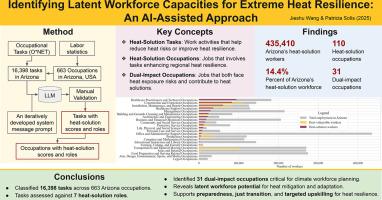识别潜在的劳动力能力极端热弹性:人工智能辅助方法
IF 9.6
Q1 COMPUTER SCIENCE, ARTIFICIAL INTELLIGENCE
引用次数: 0
摘要
极端高温事件因气候变化而加剧,对公共卫生、基础设施和劳动力复原力构成重大挑战。尽管这些挑战迫在眉睫,但目前还没有系统的框架来确定劳动力适应能力,以帮助建立区域热恢复能力。本研究引入了一种新的大型语言模型辅助方法,使用来自O*NET数据集的任务级数据来确定提高热恢复能力的劳动力能力。通过将热解决任务定义为减轻热影响、保护公众健康或改善基础设施的活动,我们将热解决职业和双影响职业进行了分类,这些职业既易受热影响,又对热恢复能力至关重要。美国亚利桑那州的一个案例研究分析了663个职业的16,398个任务,确定了110个热解决职业(约占亚利桑那州劳动力的14%)和31个双影响职业。该研究揭示了与能源相关的职业,如暖通空调技术人员、太阳能安装人员和改造专家,如何促进气候适应,将职业角色与清洁能源转型和弹性基础设施联系起来。通过利用大型语言模型,我们的方法提供了一个可扩展的、人工智能驱动的工具来分析劳动力数据,并确定能源效率和灾害抵御能力所需的能力。这些发现不仅证明了大型语言模型在劳动力分析中的潜力,而且有助于制定亚利桑那州的第一个极端高温准备计划。该研究提供了一种可扩展的方法来发现潜在的能力,并为劳动力发展、安全法规和气候适应型基础设施的政策提供信息,可作为面临类似挑战的其他地区的典范。本文章由计算机程序翻译,如有差异,请以英文原文为准。

Identifying latent workforce capacities for extreme heat resilience: An artificial intelligence assisted approach
Extreme heat events, intensified by climate change, pose critical challenges to public health, infrastructure, and workforce resilience. Despite the urgency of these challenges, there is no systematic framework to identify workforce adaptive capacities that can help build regional heat resilience. This study introduces a novel large language model assisted approach, using task-level data from the O*NET dataset, to identify workforce capacities that enhance heat resilience. By defining heat-solution tasks as activities mitigating heat impacts, protecting public health, or improving infrastructure, we classify heat-solution occupations and dual-impact occupations, which are both vulnerable to heat and critical to heat resilience. A case study of the state of Arizona in the United States analyzed 16,398 tasks across 663 occupations, identifying 110 heat-solution occupations (about 14 % of Arizona’ workforce) and 31 dual-impact occupations. The study reveals how energy-relevant occupations, such as HVAC technicians, solar installers, and retrofit specialists, contribute to climate adaptation, linking occupational roles to the clean energy transition and resilient infrastructure. By leveraging large language models, our method provides a scalable, AI-powered tool to analyze workforce data and identify capacities necessary for energy efficiency and hazard resilience. The findings not only demonstrate the potential of large language models in workforce analysis but also contributed to shaping Arizona’s first Extreme Heat Preparedness Plan. This study offers a scalable method to uncover latent capacities and informs policies on workforce development, safety regulations, and climate-resilient infrastructure, serving as a model for other regions facing similar challenges.
求助全文
通过发布文献求助,成功后即可免费获取论文全文。
去求助
来源期刊

Energy and AI
Engineering-Engineering (miscellaneous)
CiteScore
16.50
自引率
0.00%
发文量
64
审稿时长
56 days
 求助内容:
求助内容: 应助结果提醒方式:
应助结果提醒方式:


